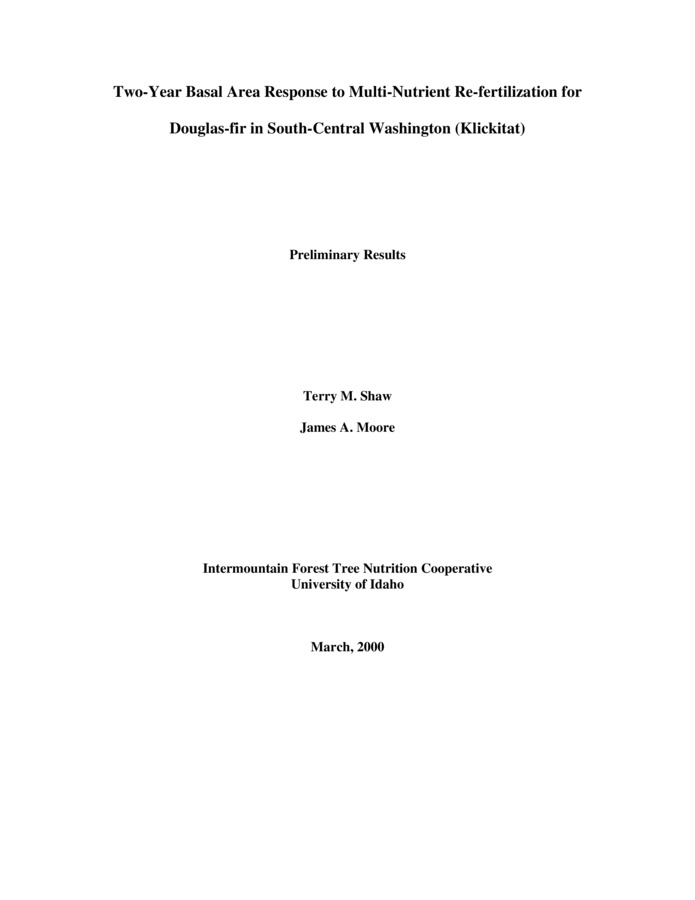PDF
Two-Year Basal Area Response to Multi-Nutrient Re-fertilization for Douglas-fir in South-Central Washington (Klickitat) Item Info
- Title:
- Two-Year Basal Area Response to Multi-Nutrient Re-fertilization for Douglas-fir in South-Central Washington (Klickitat)
- Creator:
- Shaw, T.M.; Moore, J.A.
- Date Created (ISO Standard):
- 2000-03-01
- Approximated Date:
- yes
- Description:
- Six fertilization study sites located in the Klickitat region of south-central Washington were established and fertilized in 1990 and then re-fertilized in 1998. Six-year plot response by treatment from the initial fertilization was analyzed and presented in 1997. Two-year re-fertilization plot response by treatment is presented here in short summary form with a final report to follow after further analysis. A brief introduction with site characteristics (Table1), treatments (Table 2) plot response by treatment tables (Tables 3-6) and vector analysis interpretation and diagnosis (Figures 1) follow this summary. Two-years after re-fertilization the average gross basal area response overall sites combined was - 3.7%, -3.7% and 0.1% for N, N+S and N+S+Micro applications, respectively (Table 3). In comparison, overall six-year volume response reported by Garrison (1997) was positive but was also poor with 10.3% and 8.4% response on the N and N+K applications, respectively (Table 4). Comparison of geologic parent materials underlying the sites showed that four installations occur on Wanapum basalt, one on Grande Ronde basalt and one on landslide olivine basalt. The Wanapum basalt and olivine basalt responded poorly but the single installation which occurred on a Grande Ronde basalt responded very well, with 30.7%, 36.0% and a significant (p < 0.10) 61.3% for N, N+S and N+S+Micro applications, respectively (Table 5). Similarly, six-year volume response also showed this pattern with sites on Wanapum and olivine basalt responding poorly (data not shown, Garrison et al, 1997) while Grande Ronde basalt response was good with 35.7% and 30% for the N and N+K applications (Table 6). It appears that all the significant (p < 0.10) positive re-fertilization effect was due to the growth response of the Grande Ronde basalt. Notably, the addition of micro nutrients in the 1998 re-fertilization increased response over the N+S treatment by 25.3%. Notably, other IFTNC sites located on Grande Ronde and Wanapum parent materials show similar response trends. Grande Ronde sites almost always respond well to fertilization while Wanapum sites almost always respond poorly to fertilization. Vector analysis of foliar response (Shaw and Moore, 1999) also diagnosed Grande Ronde basalt as the best responder to fertilization (Figure 1). Furthermore, vector analysis diagnosed good foliar response for Wanapum and olivine basalts, however, this good foliar response did not translate into good two-year basal area growth response for these two rock types. Perhaps nutrients other than those that were applied in the fertilizer mix were deficient and in-turn reduced response on the Wanapum and olivine basalts. For example, vector analysis identified possible Ca deficiencies for olivine basalt and P deficiencies for Wanapum basalt (Figure 1). Further testing needs to be done to determine the validity of Ca and P deficiencies or other possible growth reducing site factors. Many "site induced" confounding factors have complicated the results given in this report. In response, additional analysis is now being performed and will be presented in a final report.
- Subjects:
- research (document genres) fertilizer timber (lumber) statistics
- Location:
- North and Central Idaho; Eastern Washington; Western Montana; Northeastern Oregon
- Publisher:
- Intermountain Forest Tree Nutrition Cooperative, University of Idaho, College of Forest, Wildlife and Range Sciences, Moscow
- Source:
- Shaw, T.M. and J.A. Moore. 2000. Two-Year Basal Area Response after Multi-Nutrient Fertilization for Douglas-fir in South-Central Washington (Klickitat). IFTNC, College of Natural Resources, Univ. of Idaho, Moscow.
- Source Identifier:
- Two-Year_Basal_Area_Response_to_Multi-Nutrient_Re-Fertilization_for_DF_in_SC_Washington_(Klickitat)_IFTNC_2000
- Type:
- Text
- Format:
- application/pdf
- Language:
- eng
Source
- Preferred Citation:
- "Two-Year Basal Area Response to Multi-Nutrient Re-fertilization for Douglas-fir in South-Central Washington (Klickitat)", Idaho Forestry Research Collection, University of Idaho Library Digital Collections, https://www.lib.uidaho.edu/digital/forestryresearch/items/forestryresearch916.html
Rights
- Rights:
- In copyright, educational use permitted. Educational use includes non-commercial reproduction of text and images in materials for teaching and research purposes. For other contexts beyond fair use, including digital reproduction, please contact the University of Idaho Library Special Collections and Archives Department at libspec@uidaho.edu. The University of Idaho Library is not liable for any violations of the law by users.
- Standardized Rights:
- http://rightsstatements.org/vocab/InC-EDU/1.0/

